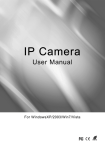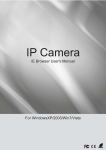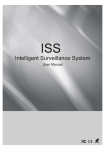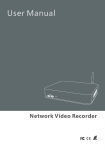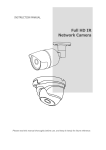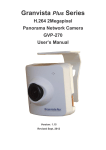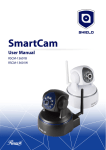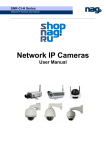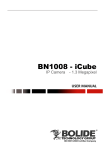Download 3.5 Configure
Transcript
0 IP Camera User Manual Preface Thank you for purchasing our product. If there is any question or request, please do not hesitate to contact dealer. This manual is applicable to IP Camera. This manual may contain several technical inaccuracies or typographical errors, or places that do not match the product. If you have any unsolved problems in the process of using product according to this manual, please contact our technical support department. The content of this manual may be updated at irregular intervals without prior notice. This manual is for reference only. IP Camera’s functions and operations with different models may be different, please regard the actual product as the truth. 1 IP Camera User Manual Table of Contents Chapter 1 Product Introduction ..................................................................................... 1 1.1 Overview ................................................................................................................. 1 1.2 Main Features ......................................................................................................... 1 1.3 Caution .................................................................................................................... 2 1.4 Audience ................................................................................................................. 3 Chapter 2 System Connection ....................................................................................... 4 Chapter 3 Access IPC through IE Browser ................................................................... 5 3.1 Download and Install ActiveX .................................................................................. 5 3.2 User Login ............................................................................................................... 6 3.3 Live Video ............................................................................................................... 7 3.3.1 Video Control ................................................................................................... 7 3.3.2 PTZ Control ...................................................................................................... 8 3.4 Playback.................................................................................................................. 9 3.5 Configure................................................................................................................ 11 3.5.1 Network Configure .......................................................................................... 11 3.5.2 Stream Configure ........................................................................................... 12 3.5.3 Time Configure ............................................................................................... 14 3.5.4 OSD Configure ............................................................................................... 15 3.5.5 Privacy Regional ............................................................................................ 16 3.5.6 SD Card ......................................................................................................... 16 3.5.7 PTZ Configure ................................................................................................ 18 3.5.8 Record Configure ........................................................................................... 19 3.5.9 Alarm Configure ............................................................................................. 20 3.5.9.1 Motion Detection ..................................................................................... 20 3.5.9.2 I/O ........................................................................................................... 22 3.5.9.3 PIR .......................................................................................................... 23 3.5.10 Advanced Configure ..................................................................................... 24 3.5.10.1 Capture Configure................................................................................. 24 3.5.10.2 Audio Configure .................................................................................... 25 3.5.10.3 WiFi Configure ...................................................................................... 25 3.5.10.4 PPPoE Configure .................................................................................. 28 2 IP Camera User Manual 3.5.10.5 DDNS Configure ................................................................................... 29 3.5.10.6 E-mail Configure ................................................................................... 30 3.5.10.7 FTP Configure....................................................................................... 31 3.5.10.8 User Management ................................................................................ 31 3.5.10.9 Connection Management ...................................................................... 32 3.5.10.10 Day/Night Configure............................................................................ 33 3.5.10.11 ISP Configure ...................................................................................... 34 3.5.11 Device Maintenance ..................................................................................... 35 3.5.11.1 Device Information ................................................................................ 35 3.5.11.2 Restore Defaults ................................................................................... 36 3.5.11.3 Restart Device....................................................................................... 36 3.5.11.4 Upgrade Device .................................................................................... 37 3.5.11.5 Running State ....................................................................................... 38 3.5.11.6 Version .................................................................................................. 38 3.5.11.7 Import/Export Settings ........................................................................... 38 3.5.12 Local Configure ............................................................................................ 39 3.6 Log ........................................................................................................................ 39 3.7 Logout ................................................................................................................... 40 Chapter 4 Mobile Surveillance ..................................................................................... 41 For Android ................................................................................................................ 42 4.1 Main Functions ...................................................................................................... 42 4.2 Installation ............................................................................................................. 42 4.3 Application Running .............................................................................................. 43 4.3.1 Interface Description ...................................................................................... 43 4.3.2 Live Preview................................................................................................... 45 4.3.3 Add Device ..................................................................................................... 46 4.3.4 Switch Channel .............................................................................................. 47 4.3.5 PTZ Control .................................................................................................... 48 4.3.6 Local Video .................................................................................................... 49 4.3.7 Saved Photos ................................................................................................. 50 4.3.8 Switch Language ........................................................................................... 50 4.3.9 Video Remote ................................................................................................ 50 4.3.10 Real-Time Alarm .......................................................................................... 51 3 IP Camera User Manual For Iphone.................................................................................................................. 51 4.4 Main Functions ...................................................................................................... 51 4.5 Installation ............................................................................................................. 52 4.6 Application Running .............................................................................................. 52 4.6.1 Interface Description ...................................................................................... 52 4.6.2 Live Preview................................................................................................... 54 4.6.3 Add Device ..................................................................................................... 55 4.6.4 Switch Channel .............................................................................................. 56 4.6.5 PTZ Control .................................................................................................... 57 4.6.6 Local Video .................................................................................................... 58 4.6.7 Saved Photos ................................................................................................. 59 4.6.8 Switch Language ........................................................................................... 59 4.6.9 Video Remote ................................................................................................ 60 4.6.10 Real-Time Alarm .......................................................................................... 60 Appendix 1 Factory Default Parameters ..................................................................... 61 Appendix 2 SearchTool User Guide ............................................................................ 62 Appendix 3 Configure the Wireless Router................................................................. 65 Appendix 4 Apply for DDNS Service ........................................................................... 67 Appendix 5 Visit IP Camera under Different Network Environments ....................... 70 Appendix 6 Port Mapping ............................................................................................. 75 Appendix 7 Network Cable Connection ...................................................................... 77 Appendix 8 FAQ ............................................................................................................ 78 4 IP Camera User Manual Chapter 1 Product Introduction 1.1 Overview This series of products are all-in-one IP Cameras (IPC for short) designed for network video surveillance, including Network Box Camera, Network Dome Camera, Network IR Camera, Network Speed Dome, etc. These digital equipments compress real-time video stream and transmit to different clients over the network with embedded real-time operating system. The remote user can view camera video through standard web browser at any moment without any professional software, and authorized users can control PTZ and configure system. IP Camera is a new generation product of combining traditional camera and network video technology, and capable of providing the following features: based on the Ethernet control; adopt high-performance processing chip and platform to ensure high reliability and stability; adopt H.264 compression algorithm to effectively save network transmission bandwidth and HDD storage space; support dynamic configuration for stream parameters; support a large number of protocols, such as PPPoE, DHCP, UDP, TCP/IP, RTSP, NTP, ONVIF, etc; support bidirectional voice talkback, OSD overlay and motion detection; with built-in Web server, allow users to easily perform real-time monitoring and remote control IP Camera via IE browser; support three-stream (main stream, sub stream and mobile stream selectable) for transmission and record; support local and remote alarm linkage; adopt high-speed embedded 3A (AWB, AF, AE) to make the image clearer, smoother and more realistic. IP Camera can be widely applied to family, office, enterprise, supermarket, factory, chain store, school and other occasions that require remote network video transmission and monitoring. 1.2 Main Features Use 5 megapixel sensor with progressive scan to provide clearer images. Support H.264 and MJPEG encoding, high-performance SOC, three-stream output 1 IP Camera User Manual technology, and maximum support 1080P@30fps Based on embedded architecture, integrate multiple functions, such as video and audio collection, signal processing, encoding, intelligent analysis, storage, network transmission, etc. Built-in WEB server, network adaptive technology support for multi-user access and preview HD video simultaneously, delay <250ms. Support mobile surveillance by Iphone, Ipad and Android phone, compatible with PC/mobile access Use the disk pre-allocated technology to effectively improve the efficiency of disk Support SD card storage and full video storage strategy, the data is correct without missing Multiple alarm functions and interfaces, integrate internally PTZ control, I/O and other interface Support AWB, AE, AGC Support DDNS, UPNP, WIFI, PPPOE and other functions Front and back ends interoperable, fully support ONVIF, RTSP Use the switching function of ICR filter to achieve day and night surveillance Convenient user rights management, effectively protect privacy Integrate audio, support voice intercom The true digital solution Easy to install and configure 1.3 Caution Please read this user manual carefully before using the camera, and keep it well for future reference. Please transport, use and place the camera in allowable temperature and humidity range. Please avoid heavy stress or violent vibration. To reduce the risk of fire or electrical shock, do not expose this product near the heat, water or moisture. Please disconnect any cables during an electrical storm or the camera will not be 2 IP Camera User Manual used for an extended period of time. Must observe all electrical safety standards; make sure the power supply voltage is correct before using the camera. Do not aim the camera lens at the strong light, otherwise it will cause fatal damage to photosensitive element. Do not install the camera near the outlet of air conditioners, otherwise lens will become fuzzy due to condensation. If cleaning is necessary, use dedicated lens paper or a clean soft cloth with a bit of neutral detergent diluted with water and wipe it gently. If the product does not work properly, please contact your dealer or the nearest service center. Never attempt to disassemble the camera yourself. 1.4 Audience This manual applies to the following persons: System planning person Technical support and maintenance person Administrator End users, retailers, professional users and ordinary civilian users, etc. 3 IP Camera User Manual Chapter 2 System Connection When using this product for the first time, please read Connection Figure carefully as shown in Fig 2-1. Any wrong wiring may lead to damage the IPC or other equipment. Fig 2-1 Note: The picture is only for reference, Please make the object as the standard. Item Name Description 1 V-OUT 2 POE/ETHERNET 3 DC 12V Power input: DC 12V 4 POWER POWER Indicator 5 RS485 Connect to PTZ. 6 ALARM IN: alarm input: connect to external alarm sensor. A/B: alarm output: connect to external alarm output device. 7 WIFI 8 MICRO SD 9 A-OUT 10 MIC-IN Video output: connect to monitor with BNC interface. POE Power supply/Network connector. Insert WIFI antenna. Insert SD card for local storage. Audio output: connect to sound box and other audio output equipment. Audio input: connect to microphone and other audio collecting equipment. 4 IP Camera User Manual Chapter 3 Access IPC through IE Browser 3.1 Download and Install ActiveX You need to install ActiveX Control when you access IP Camera for the first time through IE browser. Installation Method: 1) Input the IP address of IP Camera in browser address bar (for example: 192.168.1.10) to enter into login page. 2) Click [Download ActiveX], as shown in Fig 3-1: Fig 3-1 3) File download dialogue box pops up, click [Run] or [Save] to download ActiveX. 4) After the download is complete, double-click the downloaded file “WebClient”, select installation path, click [Install] button to install “WebClient”, as shown in Fig 3-2: Fig 3-2 5 IP Camera User Manual 5) After installation is complete, click [Finish] button to exit, as shown in Fig 3-3: Fig 3-3 3.2 User Login Reopen IE browser after ActiveX installation completes, input the IP address of IP Camera (192.168.1.10 by default) to enter into login page, as shown in Fig 3-4. Select the system language, input user name and password, then click [Login] button to enter the main interface. Fig 3-4 Note: The default user name is “admin”, the default password is blank. 6 IP Camera User Manual 3.3 Live Video After signing in you will see the live video page, or click [Live Video] button in menu bar to enter this interface. User can do many operations like play, stop, record, capture, talkback, full-screen view, audio monitor, buffer, show alarm and PTZ control, video parameter adjustment, etc. As shown in Fig 3-5: Fig 3-5 3.3.1 Video Control [Stream ID]: Select the stream according to the network environment: main stream is HD channel, sub stream is SD channel, and mobile stream is throttle channel. [Protocol]: Support TCP, UDP network protocol. [Play]: Click this button to open the current video screen. 7 IP Camera User Manual [Stop]: Click this button to close the current video screen. [Record]: Manual recording switch. Click this button to record current video, and save them in AVI format to “Local recording files path” of local configure; the state is changed to after enable recording, click this button to stop recording. [Capture]: Click this button to snap current image, and save it in JPG format to “Local capture files path” of local configure. [Talkback]: Audio talkback switch. Click this button to perform the talkback between PC and IP Camera; the state is changed to after enable audio talkback, click this button to stop talkback. [Show Alarm]: Click this button to pop up alarm information list, it shows the alarm IP, alarm time and alarm description. [Audio]: Open or close the sound of live video. [Use Buffer]: In order to avoid the stagnation caused by network congestion during video playback, using buffer function can save a certain amount of data (150/800/1500/3000ms) before playing video. The longer buffer time you set, the longer delay video plays. [Full Screen]: Double-click the video screen to display video in full-screen, double-click again or press Esc key to exit full screen mode. [Video Parameters]: Adjust the brightness, hue, contrast, saturation and sharpness of video, click [Default] button to restore default values. Note: Support 5 users online at the same time. 3.3.2 PTZ Control [PTZ Speed]: Eight grades: 1~8, “1” is slowest, “8” is fastest, and “5” is moderate. [PTZ Rotation]: Four rotation directions: up, down, left, right; Zoom, focus and lris are adjustable. [Preset]: Set, remove and call any preset point with a maximum of 128, as shown in Fig 3-6: 8 IP Camera User Manual Fig 3-6 3.4 Playback Click [Playback] button in menu bar to enter the video playback page, as shown in Fig 3-7: Fig 3-7 9 IP Camera User Manual User can search for recording files or capture images in local PC or storage device on the IP Camera according to search criteria. [Position]: Select remote recording files, remote capture images, local recording files or local capture images. [Type]: Select the file type; remote recording files can be searched by motion alarm recording, I/O alarm recording and time recording, local recording files can be searched by local files and download files. [Date]: Select a certain date. [Start Time / End Time]: Set a specific time period. [Files List]: Click [Search] button after setting the search criteria, the searched files information will be displayed in the Files List. [Play]: Double-click video or click picture file in the files list, or click button to playback. The contents will be displayed in the video playback window. Supporting files switch, capture, download and position playback by dragging the progress bar during playback. As shown in Fig 3-8: Fig 3-8 (1) Play Process Bar (2) Play (3) Stop (4) Next Segment (5) Last Segment (6) Capture (7) Download (8) Full Screen [Download]: Select remote recording files or remote capture images in the files list, and click this button to download to your PC. IP Camera cannot search and download files again during the download process. 10 IP Camera User Manual 3.5 Configure Click [Configure] button to enter the parameter setting page. 3.5.1 Network Configure The interface of network parameters is shown in Fig 3-9: Fig 3-9 [Device Port]: Default value is 5000 (users are recommended not to change it). [Web Port]: Default value is 80 (users are recommended not to change it). [RTSP Port]: Default value is 554 (users are recommended not to change it). [ONVIF Port]: Default value is 12001 (users are recommended not to change it). [DHCP]: If DHCP function of router is enabled, IP Camera will automatically obtain IP 11 IP Camera User Manual address from the router, and revert to manual IP automatically when DHCP failed. [IP Address]: Set the IP Camera’s IP address. [Net mask]: Default value is 255.255.255.0 (users are recommended not to change it). [Gateway]: Set the IP Camera’s gateway. When the device is connected to public network via a router, gateway should be set to the router’s IP. [Multicast address]: Multicast means the hosts of a group can receive all the data within this group. Set the IP address and port number of multicast. [DNS Server]: The default server is the DNS address of Guangdong province. Using DDNS function outside this area need to set the DNS address as their local DNS address. Click OK button to save the setting; when the setting is not saved, click “Refresh” button to return to the previously saved parameters; when the setting has been saved, click “Refresh” button to query whether the setting is successful. Note: After modify and save network parameters, IP Camera will restart. If the device is applied in LAN, please avoid conflict with the IP addresses of other devices or PC. 3.5.2 Stream Configure The interface of stream configure is shown in Fig 3-10: [Stream ID]: Support three types of stream: main stream is HD channel, sub stream is SD channel, and mobile stream is throttle channel. [Stream type]: Includes Only Video and Video & Audio. [Encode type]: Support the standard H.264 video encoding. [Frame rate]: Set the encoding frame numbers per second. The adjustable range synchronizes with stream ID. [Frame interval]: The smaller frame interval, the higher image bitrate and the better image quality you get. [Resolution]: Set the resolution of image. It can be set as 960P, 720P in the main stream; CIF, D1, VGA in the sub stream; and QCIF in the mobile stream. 12 IP Camera User Manual [Bit type]: CBR adopts constant encoding bitrate, VBR adopts variable encoding bitrate. [Stream Size]: Different stream ID has different bitrate. The range of main stream bitrate is 1000~6000kbps, sub stream bitrate is 128 ~ 768kbps (CIF), 512 ~ 2048kbps (D1), 512 ~ 1024kbps (VGA); mobile stream bitrate is 64~256kbps. The higher bitrate can generate better image quality, but it occupies more bandwidth, please adjust the bitrate value according to your actual bandwidth. Fig 3-10 Click OK button to save the setting; when the setting is not saved, click “Refresh” button to return to the previously saved parameters; when the setting has been saved, click “Refresh” button to query whether the setting is successful. Notice: Resolution and frame rate are determined by the specifications of specific model. Here take 720P IP Camera for example. 13 IP Camera User Manual 3.5.3 Time Configure The interface of time parameters is shown in Fig 3-11: Fig 3-11 [Time Setting]: Manually set the date and time of device. [Time zone]: Set the current time zone. [Daylight Saving Time]: User can enable this function, and set start & end time and shift time. [NTP Service]: Enable this function, IP Camera will sync system time with NTP server according to the time zone; user can also manually set the IP and port number of NTP server. [Sync PC time]: Click this button to sync system time with PC. Click OK button to save the setting; when the setting is not saved, click “Refresh” button to return to the previously saved parameters; when the setting has been saved, click “Refresh” button to query whether the setting is successful. 14 IP Camera User Manual 3.5.4 OSD Configure The interface of OSD configure is shown in Fig 3-12: Fig 3-12 [Time]: Enable this function to display system time. [Color]: Select different colors for time display. The background color of time area which has a transparency of 30% will automatically adjust according to the character color. [Position]: Adjust the display position of system time within resolution. [Text]: Enable this function to display text content. [Color]: Select different colors for text display. The background color of text area which has a transparency of 30% will automatically adjust according to the character color. [Position]: Adjust the display position of text content within resolution. [Text]: Click text box to self-define the channel name, it supports 40 English characters or 20 Chinese words at maximum. Click OK button to save the setting; when the setting is not saved, click “Refresh” button to return to the previously saved parameters; when the setting has been saved, click “Refresh” button to query whether the setting is successful. 15 IP Camera User Manual 3.5.5 Privacy Regional After entering the privacy regional interface, click [Privacy Regional] button to enter the Shelter Area window, as shown in Fig 3-13: Fig 3-13 Enable privacy function, click and drag cursor to set the privacy area of video image. An image can be entirely or partially masked, it supports 4 areas (superposable) at maximum. [Channel No.]: Select a channel for privacy. [Enable]: Enable or disable privacy function. [Color select]: Select the color overlay of privacy area. [Clear all]: Click this button to clear all privacy areas. [Clear select]: Click this button to clear selected privacy area. Click “Setup” button to save the setting; when the setting is not saved, click ”Query” button to return to the previously saved parameters; when the setting has been saved, click ”Query” button to query whether the setting is successful. 3.5.6 SD Card The interface of SD card configure is shown in Fig 3-14: 16 IP Camera User Manual Fig 3-14 Click [Refresh] button to view the information of SD card on the IP Camera. Click [Partition And Format] button to format SD card, it supports disk cache, smart drive, FAT32 file system and 32GB maximum capacity with a fixed partition. When the setting is not saved, click [Refresh] button to return to the previously saved parameters; when the setting has been saved, click [Refresh] button to query whether the setting is successful. Notice: Power off and restart the IP Camera to identify correctly after inserting SD card. Hot-plugging is not recommended for SD card, it may damage the data of SD card. Don’t allow formatting during the process of using SD card (capture or record). 17 IP Camera User Manual Don't cut off the power in the process of formatting. FAT32 is used to file system format by default. IP Camera doesn’t support the storage formatted into multi-partition, if user want to format SD card on PC before using, please format it into one partition. 3.5.7 PTZ Configure The interface of PTZ configure is shown in Fig 3-15: Fig 3-15 [PTZ configure]: When IP Camera is connected to RS485 communication or control device (e.g. PTZ decoder, dome camera), user need to select the correct PTZ settings according to the parameters of external communication device (address, protocol, baud rate, etc). Click OK button to save the setting; when the setting is not saved, click “Refresh” button to return to the previously saved parameters; when the setting has been saved, click “Refresh” button to query whether the setting is successful. Notice: Only setting the correct parameters and protocol can you control the external communication device. 18 IP Camera User Manual 3.5.8 Record Configure The interface of record configure is shown in Fig 3-16: Fig 3-16 [Storage rule]:When the storage space is full, “Circle write” will cover the earliest storage files and keep recording, “Not overwrite” will stop recording and generate alarm automatically. [Pre-recording]: Alarm signal needs a little time to process and trigger recording, it may not record some important information before alarm activation. This function can save pre-recording (usually is 6~7s) and improve monitoring reliability, otherwise it only writes the current video data to SD card. [Stream ID]: The smaller record stream you set, the more video files stored in SD card. Select the stream for recording: main stream is HD channel, sub stream is SD channel, and mobile stream is throttle channel. [Record Schedule]: Enable this function, user can set a daily schedule of recording. The start time should be earlier than the end time. You can copy and apply time settings to the other date or every day. Click OK button to save your settings, click Refresh button to update the schedule. Click OK button to save the setting; when the setting is not saved, click “Refresh” button to return to the previously saved parameters; when the setting has been saved, 19 IP Camera User Manual click “Refresh” button to query whether the setting is successful. Notice: Don't pull out SD card during recording. If you change the record stream during recording, it will reproduce other new video file. 3.5.9 Alarm Configure 3.5.9.1 Motion Detection The interface of motion detection configure is shown in Fig 3-17: Fig 3-17 20 IP Camera User Manual [Sensitivity]: Set the sensitivity of motion detection: low, normal, high; the higher grade means higher sensitivity. [Detection Time Interval]: The time interval between two adjacent detective motions, range from 5 to 10s. If there is other motion detected during this period, it will be considered continuous movement; otherwise should be regarded as two different motion events. [Set Motion Area]: Click this button to enter the detection region window. Click and drag cursor to set the area of motion detection. An image can be entirely or partially set, it supports 1 area for detection. Click area to select this area, click again to deselect. Click [Clear all] button to clear all detection areas. Click [Clear select] button to clear selected detection area. Click [Setup] button to save the setting. When the setting is not saved, click [Query] button to return to the previously saved parameters; when the setting has been saved, click [Query] button to query whether the setting is successful. Click close button to exit current interface. [Alarm Schedule]: Enable this function, user can set a daily schedule of motion detection. The start time should be earlier than the end time. You can copy and apply time settings to the other date or every day. Click OK button to save your settings, click Refresh button to update the schedule. [Output]: Linkage alarm output with built-in relay when alarm is triggered. [Delay]: The duration of linkage alarm output when alarm is triggered, range from 1 to 10s. [Record]: Linkage recording and store in the SD card when alarm is triggered. [Linkage Mode]: The duration of linkage recording when alarm is triggered, time range: 5/10/30/60/120/300/600/900/1200/1800s. [Capture]: Linkage capture and store in the SD card when alarm is triggered. [E-mail]: Enable this function, the alarm information of motion detection will be sent to mailbox (refer to E-mail Configure). The notification email can contain text messages and images. [FTP]: Enable this function, the alarm information of motion detection will be saved in FTP Server. User can upload text messages and images. Click OK button to save the setting; when the setting is not saved, click “Refresh” 21 IP Camera User Manual button to return to the previously saved parameters; when the setting has been saved, click “Refresh” button to query whether the setting is successful. 3.5.9.2 I/O The interface of I/O alarm configure is shown in Fig 3-18: Fig 3-18 [I/O Type]: Select the I/O alarm type according to alarm trigger type: N.O. (normally open) and N.C. (normally closed). [Alarm Schedule]: Enable this function, user can set a daily schedule of I/O detection. The start time should be earlier than the end time. You can copy and apply time settings to the other date or every day. Click OK button to save your settings, click Refresh button to update the schedule. [Output]: Linkage alarm output with built-in relay when alarm is triggered. [Delay]: The duration of linkage alarm output when alarm is triggered, range from 1 to 10s. 22 IP Camera User Manual [Record]: Linkage recording and store in the SD card when alarm is triggered. [Alarm Linkage]: The duration of linkage recording when alarm is triggered, time range: 5/10/30/60/120/300/600/900/1200/1800s. [Capture]: Linkage capture and store in the SD card when alarm is triggered. [E-mail]: Enable this function, the information of I/O alarm will be sent to mailbox (refer to E-mail Configure). The notification email can contain text messages and images. [FTP]: Enable this function, the information of I/O alarm will be saved in FTP Server. User can upload text messages and images. Click OK button to save the setting; when the setting is not saved, click “Refresh” button to return to the previously saved parameters; when the setting has been saved, click “Refresh” button to query whether the setting is successful. 3.5.9.3 PIR The interface of PIR alarm configure is shown in Fig 3-19: Fig 3-19 23 IP Camera User Manual PIR detector adopts passive infrared technology to sense the ambient temperature changes. The temperature is relatively constant in general environment (such as warehouse, corridor, etc). When the object comes in, it will cause temperature change and PIR alarm. The settings of PIR alarm are similar to motion detection and I/O alarm, please refer to Chapter 3.5.9.1 Motion Detection or 3.5.9.2 I/O for detailed operations. 3.5.10 Advanced Configure 3.5.10.1 Capture Configure The interface of capture configure is shown in Fig 3-20: Fig 3-20 [Setting]: Enable or disable timing capture function; set the time interval of capture, time range: 5/10/15/30/60s. If capture interval is set to 5s, IP Camera will capture pictures every 5 seconds in the period of capture schedule, and store them in the SD card. [Capture Schedule]: Enable this function, user can set a daily schedule of capture. The start time should be earlier than the end time. You can copy and apply time settings to the 24 IP Camera User Manual other date or every day. Click OK button to save your settings, click Refresh button to update the schedule. [FTP upload]: Enable this function to upload the pictures of timing capture to FTP Server. Click OK button to save the setting; when the setting is not saved, click “Refresh” button to return to the previously saved parameters; when the setting has been saved, click “Refresh” button to query whether the setting is successful. 3.5.10.2 Audio Configure The interface of audio configure is shown in Fig 3-21: Fig 3-21 In this interface, user can view the audio sample rate and bit wide of IP Camera, support G711a audio encoding formats. Click “Refresh” button to refresh the above info. 3.5.10.3 WiFi Configure The interface of WiFi configure is shown in Fig 3-22: 25 IP Camera User Manual Fig 3-22 WiFi setup steps are as follows: Step 1: Enter into ConfigureAdvanced ConfigureWiFi Configure, enable WiFi function of IP Camera and set up a wireless IP, or enable DHCP function to obtain the wireless IP automatically. Click “OK”, the device will automatically restart. 26 IP Camera User Manual Fig 3-23 (a) Step 2: Open IE browser and enter the IP address of wireless router, set up the router's IP, encryption mode, password, etc. (Skipping this step if your wireless router has been set) Note: The wireless IP of your router and IP Camera must be on the same network segment. Step 3: Reenter the WiFi Configure of IP Camera, click [Search router] button to automatically search router: Fig 3-23 (b) Step 4: Select your wireless router, and set up the WEP key and password, click [Connect] 27 IP Camera User Manual button. Note: If the router's security type is Auto, user can click [Connect] directly without setting parameters; if the security type is WPA, user need to enter password and then click [Connect]; if the security type is WEP, user need to set the WEP key format, WEP key and password, then click [Connect]. These settings must be consistent with wireless router. Step 5: When the connect state is displayed as "Connect", unplug the network cable of IP Camera, open IE browser and enter the wireless IP to access IP Camera. Click OK button to save the setting; when the setting is not saved, click “Refresh” button to return to the previously saved parameters; when the setting has been saved, click “Refresh” button to query whether the setting is successful. Note: Only for the models with WiFi function. If your IP Camera has no WiFi function, searching router is invalid. 3.5.10.4 PPPoE Configure The interface of PPPoE configure is shown in Fig 3-24: Fig 3-24 [Enable]: Enable or disable PPPoE dial-up function. [Dynamic IP]: Display the public IP Address after the success of dial-up. 28 IP Camera User Manual [Account/Password]: The account / password of ADSL dial-up, obtain from the internet service provider. [Dial]: Support PPPoE dialing with wired and wireless. Click OK button to save the setting; when the setting is not saved, click “Refresh” button to return to the previously saved parameters; when the setting has been saved, click “Refresh” button to query whether the setting is successful. 3.5.10.5 DDNS Configure The interface of DDNS configure is shown in Fig 3-25: Fig 5-19 Bind the device with a fixed domain name, so that user can visit the device no matter how the public IP changes. (Refer to Appendix 4 for DDNS service) [Enable]: Enable or disable DDNS function. [Domain]: The domain name set up by user, such as MyIPC.no-ip.org. [User name/Password]: User name / password registered in DDNS server. [Domain server]: Select the correct DDNS server: DDNS-3322, NO IP, DYNDNS and HDCCTVDDNS (security and stability, permanent free). [UPnP]: Enabling this function can automatically map the port currently in use to router. Click OK button to save the setting; when the setting is not saved, click “Refresh” button to return to the previously saved parameters; when the setting has been saved, click “Refresh” button to query whether the setting is successful. 29 IP Camera User Manual 3.5.10.6 E-mail Configure The interface of E-mail configure is shown in Fig 3-26: Fig 3-26 [Enable]: Enable or disable E-mail notification function. [SSL]: Enable or disable mail encryption function. [SMTP server]: Outgoing Mail Server Address. Mail server addresses are different for different Email service providers, e.g. the SMTP server of 163 mailbox is smtp.163.com, the SMTP server of Gmail mailbox is smtp.gmail.com. Gmail mailbox and 163 mailbox are now recommended. [Port]: Port number of SMTP server, usually is 25 or 465, or it may be 587, 993, etc. [Sender address]: The E-mail address of sending mail. [Recipient address]: The E-mail address of receiving mail. Here user can add two E-mail addresses at most. [Sender name]: Sender’s name. [User name]: E-mail login user name. [Password]: E-mail login password. [Subject]: The subject of sending messages. 30 IP Camera User Manual Click OK button to save the setting; when the setting is not saved, click “Refresh” button to return to the previously saved parameters; when the setting has been saved, click “Refresh” button to query whether the setting is successful. 3.5.10.7 FTP Configure The interface of FTP configure is shown in Fig 3-27: Fig 3-27 When alarm is triggered, IP Camera will upload text messages and images to FTP server. [Enable]: Enable or disable FTP function. [Server address]: FTP server’s IP address or domain name, such as 192.168.1.119. [Port]: FTP server’s port number, the default value is 21. [User name/Password]: FTP server’s user name and password. [FTP Directory]: Set the transmission path on remote FTP server. Click [/Device Name] and [/Channel Name] button to create a path quickly. It can rename the file, reconnect automatically when time out, and create folders automatically in the root directory of FTP server. Click OK button to save the setting; when the setting is not saved, click “Refresh” button to return to the previously saved parameters; when the setting has been saved, click “Refresh” button to query whether the setting is successful. 3.5.10.8 User Management The interface of user management is shown in Fig 3-28: 31 IP Camera User Manual Fig 3-28 Enter the new user's name and password, set the appropriate user right, then click [Add] button to add this user into the user list. Select a user in the user list, modify user information or right, and then click [Modify] button to confirm the change. Select a user in the user list, click [Delete] button to delete this user. Note: 10 users can be added for each IP Camera at most. The admin cannot be modified and deleted. 3.5.10.9 Connection Management The interface of connection management is shown in Fig 3-29: In this interface, user can view all user information. Click “Refresh” button to refresh the online user list. User can preview and operate device remotely through IE browser, ISS 32 IP Camera User Manual and other client. Clicking “Disconnected” button can take the client offline. Fig 3-29 3.5.10.10 Day/Night Configure The interface of day/night configure is shown in Fig 3-30: [Day/Night Switch Schedule]: Enable this function, user can set a daily schedule of switch. The start time should be earlier than the end time. You can copy and apply time settings to the other date or every day. Click OK button to save your settings, click Refresh button to update the schedule. [Sensitivity]: Set the sensitivity of sensor in low-light conditions: high, normal, low. Click OK button to save the setting; when the setting is not saved, click “Refresh” button to return to the previously saved parameters; when the setting has been saved, click “Refresh” button to query whether the setting is successful. 33 IP Camera User Manual Fig 3-30 3.5.10.11 ISP Configure The interface of ISP configure is shown in Fig 3-31: Fig 3-31 34 IP Camera User Manual [Brightness / Contrast / Hue / Saturation / Sharpness]: Drag the slider to adjust the brightness, contrast, hue, saturation and sharpness of video, range from 1 to 255. [Exposure]: Support auto exposure. It will adjust exposure automatically according to the intensity of light. [Video Standard]: In indoor environment, if the flashing lamps result in image scintillation, please select 50HZ or 60HZ according to the power frequency. [Mirror Mode]: Enable or disable mirroring function, set the mirror / flip / mirror and flip mode, video will rotate horizontally / vertically / both horizontally and vertically. [AWB Mode]: Select the appropriate mode according to the actual monitoring environmental. There are six modes to choose from. [Noise Reduction Level]: Drag the slider to set the processing level of reducing noise, range from 1 to 10. [Indoor And Outdoor]: Select indoor or outdoor mode to get the suitable display result. Click OK button to save the setting; when the setting is not saved, click “Refresh” button to return to the previously saved parameters; when the setting has been saved, click “Refresh” button to query whether the setting is successful. 3.5.11 Device Maintenance 3.5.11.1 Device Information The interface of device information is shown in Fig 3-32: Fig 3-32 In this interface, user can self-define device name and channel name displayed in the search list while searching for devices. They support 24 characters (only contain Chinese 35 IP Camera User Manual characters, letters, numbers and underline). Click OK button to save the setting; when the setting is not saved, click “Refresh” button to return to the previously saved parameters; when the setting has been saved, click “Refresh” button to query whether the setting is successful. 3.5.11.2 Restore Defaults The interface of restore defaults is shown in Fig 3-33: Fig 3-33 Click [Factory Default] button to pop up a warning window, then click OK button to restore factory settings and restart the device automatically. Click [Restore] button to pop up a warning window, then click OK button to restore default values and restart the device automatically. Notice: “Restore factory settings” can restore all user settings and network parameters; “Restore default values” can restore all user settings and reserve network parameters. 3.5.11.3 Restart Device The interface of restart device is shown in Fig 3-34: 36 IP Camera User Manual Fig 5-27 Click [Device Restart] button to pop up a dialog box, then click OK button to restart IP Camera. 3.5.11.4 Upgrade Device The interface of upgrade device is shown in Fig 3-35: Fig 3-35 Click [Browse] button to select the correct upgrade file, then click [Upgrade Device] button to upgrade device, and upgrade status bar will show the current progress. After upgrade completes, IP Camera will restart automatically. User need to login again, and enter into version page to check the version number. Note: The suffixes of upgrade files for network are “.ram”, for example, kernel file is kernelfs.ram, burn file is burnin.1.0.ram, boot file is nsboot.1.0.ram, and application file is usersection.2.0.8.ram. 37 IP Camera User Manual Notice: Don’t cut off the power and internet connection in the process of upgrade, IP Camera cannot be recovered after power off. 3.5.11.5 Running State In this interface, user can view the CPU and memory utilization, running time and hard disk space. Click “Refresh” button to refresh these info in real time. 3.5.11.6 Version In this interface, user can view the version number, build date, core version, etc, as shown in Fig 3-36. Click “Refresh” button to refresh these information. Fig 3-36 3.5.11.7 Import/Export Settings The interface of import/export settings is shown in Fig 3-37: Fig 3-37 User can export the data files of IP Camera into PC as backup function, or import specified data files from PC to IP Camera. 38 IP Camera User Manual 3.5.12 Local Configure The interface of local configure is shown in Fig 3-38: Fig 3-38 Click [Browse] button to configure the download path of remote recording files and remote capture files, configure the storage path of local recording files and local capture files. [Display mode]: Select the video display mode. Two options: full of window and original proportion. [Length of recording file time]: Select the recording time for each local recording file. Click OK button to save the setting; when the setting is not saved, click “Refresh” button to return to the previously saved parameters; when the setting has been saved, click “Refresh” button to query whether the setting is successful. 3.6 Log Click [Log] button to enter the log search page. [Start Date / End Date]: Select the start date and end date. [Log Type]: Select the type of log. Five options: all types, system, alarm, operation and network. After setting the search criteria, click [Refresh] button to search log, the searched log information will be displayed in the log list, as shown in Fig 3-39: 39 IP Camera User Manual Fig 3-39 3.7 Logout Click [Logout] button to log out, and return to the login page. 40 IP Camera User Manual Chapter 4 Mobile Surveillance You can remotely view Camera streams from your DVR, IPC, IP PTZ and NVR on your iPhone™,iPad™, or Android™ device. Compatible Mobile Viewing Devices iPhone (4.0 and above) iPad (4.0 and above) Android(1.6 and above) NOTE: Instant Mobile Viewing on an iPhone™ using an iPhone™ App. Free download available from Apple™ Store under the name “ISSMOBILE”. Compatible with iPhone™ version 4.0 and above. Selectable 4 channels live viewing. Mobile phone data plan is required (not included). Router port forwarding is required. NOTE: Instant Mobile Viewing on an iPad™ using an iPad™ App. Free download available from Apple™ Store under the name “ISSMOBILE HD”. Compatible with iPad™ version 4.0 and above. Selectable 9 channels live viewing. Mobile phone data plan is required (not included). Router port forwarding is required. NOTE: Instant Mobile Viewing on Android™ 1.6 and above. Free download available from Google™ play store under the name “ISSMOBILE”. Selectable 4 channels live viewing. Mobile phone data plan is required (not included). Router port forwarding is required. Before You Begin You will need the following before you can start mobile viewing on your iPhone or Android device: The IP address or DDNS host name of your DVR or IP Camera: For details, please refer to the user manual. The TCP Port Number of your DVR or IP Camera: By default, the port number is 5000. User name and Password of your DVR: By default, the ID is admin, no password. 41 IP Camera User Manual For Android 4.1 Main Functions Support Chinese and English; View the Cameras on real time via wifi and 3G; Support multi-channel switching; Support remote play; Support device configuration, modification and delete; Support photo view and save; Support video view and save; Support IP and DDNS access; Support Pan, Tilt & Zoom control; Support Snap-shot; Support video records; Adopt direct connection device, without any third party server transit; 4.2 Installation Users can free download this app from Google™ play store on Android™ 1.6 and above, you may first search “ISSMOBILE”, like Fig 4-1 as below. Router port forwarding is required. Then click “Install”, the application will be automatically installed into your mobile phone, like Fig 4-2 as below: 42 IP Camera User Manual Fig 4-1 Fig 4-2 4.3 Application Running 4.3.1 Interface Description After successfully installed the application into mobile phones, it is ready to run, just click the ISS MOBILE icon in the main menu. The main interface looks like Fig 4-3: Click “ ” icon on top right, then you can access the main menu interface and see corresponding operation options, including device list, local video, photos, about, etc; refer to Fig 4-4: 43 IP Camera User Manual Fig 4-3 Fig 4-4 Device List: Add a new device, or modify the device settings. Local Video: If ISS MOBILE has record function, after clicking video records, you will see the details of the records. The name of the record file will be generated by system default according to recording time. Video Remote: Access the device recorded clips and view the video. Saved Photos: Save the snapshot on the phone when viewing the IP Camera through the phone; after clicking it, you will see the photos as thumbnail. Enlarge the photos by clicking it. Setting: After clicking it, you can set password protection, alarm sound, etc; refer to Fig 4-5: About: The related information of the application. Fig 4-5 44 IP Camera User Manual 4.3.2 Live Preview Click back key on top left in the main menu interface, back to display interface, refer to Fig 4-6: Fig 4-6 Instructions of the functions on “Live Preview” interface as below: Function Key Description Channel selecting: You can select the channels playing Select the group of channels Play / Stop / Snapshot Video Records Quick Access Device List, edit and select the device Alarm function Left Slip to Display PTZ Control Button Control the directions of the Camera 45 IP Camera User Manual Function Key Description / Zoom in / Zoom out Change focus and aperture 4.3.3 Add Device If this is the first time to use ISS MOBILE app, you need to put in all the information needed. Steps as below: Click “ Click “ ” to access “Device List” interface, the list is blank as this time. ” on “Device List” on bottom left to access “Detail” interface, like Fig 4-7 as below: Fig 4-7 Device Name: The names of equipment, which can help you identify different devices, for examples, you can type the names based on the location of the equipment. The name will be showed on the topside title bar of display interface. Address: DVR IP address (must be an Internet address) or DDNS. Port: It means mobile phone port, and you can acquire port number in the setting information of the device. Please use the fixed port: 554 here. User Name: The user name of terminal device. 46 IP Camera User Manual Password: The password of terminal device, match with user name. Max Channel: The channels of your DVR supported, 32 channels max. After editing, please click “Save” to save the information. Click “Back”, turn back to “Device List”, you will see the name, channels, address, etc, like Fig 4-8 as below: Fig 4-8 Click “ Fig 4-9 ” and Device to edit setting information. For example, click “device 66” in “Device List”, you could modify the settings of “device 66”. Click “ ” to delete the selected device. For example, click “device 64” in “Device List”, will show notice like Fig 4-9, select “OK”, and delete “device 64”. 4.3.4 Switch Channel Select the numbers showed in Area 3 in Figure 6-10 to switch channels; select Area 2 to switch channel-group, and then select the numbers in this channel-group to switch the channels. Switch the channels within different devices: If you want to switch to the channels on other devices, steps as below: 1) Press “ 2) Click “+” on display interface, like Area 1 in Fig 4-10, then access device list interface, ” to stop or turn the playing video off; like Fig 4-11: 47 IP Camera User Manual Fig 4-10 3) Fig 4-11 Fig 4-12 Select the device which switched to, will show the channel list of this device, like Fig 4-12 as below: 4) Select the channels in the channel list of this device, turn back to display interface to view the Camera of this channel. 4.3.5 PTZ Control Left slip “ ” to “PTZ Control”, like Fig 4-13 as below: Fig 4-13 Function keys of PTZ control as below: :Control PTZ direction; :Zoom in and zoom out; 48 IP Camera User Manual :Change focus; :Change aperture. 4.3.6 Local Video The videos will be saved on the phone after recording the videos. Steps as below: Note: If there is no memory card on phone, the record function will not work. Play Video: 1) Click “ ” to access main menu interface, select “local video” to access “local video” list interface, like Fig 4-14: 2) Click the video record, for example 20121022145057.mp4, to view this video record. Fig 4-14 Delete: 1) Click “ ” to access the main menu interface, select “local video” to access “local video” list interface, like Fig 4-14: 2) Click “ ”, select the needed record, like Fig 4-15, click “ 3) Click “Done” and back to “Local Video” list interface; 4) Click “Back” and back the main menu, like Fig 4-16: 49 ” to delete this video. IP Camera User Manual Fig 4-15 Fig 4-16 Note: 1) In the all operation steps, you could click “Done” to end up, cancel the operation and back the last step. 2) You have to make sure there are video records, so that you could search the records; if not, you cannot search it. 4.3.7 Saved Photos The photos are the snap-shot when viewing the Cameras which saved on the album. You also can check and batch save and delete etc. The steps are the same as 4.3.6. 4.3.8 Switch Language When you switch the language on your phone, the language of the application will be changed as well. For example, it’s switched to English on your phone, the language of the application will be switched to English as well. 4.3.9 Video Remote You can access the device recorded clips with the app and view the video clips. Select the right device, channel and time then tap search, like Fig 4-17: 50 IP Camera User Manual 4.3.10 Real-Time Alarm When any channel has any alarming info, the app will show up in the main interface, like Fig 4-18: Fig 4-17 Fig 4-18 For Iphone 4.4 Main Functions Support Chinese and English; View the Cameras on real time via wifi and 3G; Support multi-channel switching; Support remote play; Support device configuration, modification and delete; Support photo view and save; Support video view and save; Support IP and DDNS access; Support Pan, Tilt & Zoom control; Support Snap-shot; Support video records; Adopt direct connection device, without any third party server transit; 51 IP Camera User Manual 4.5 Installation Users can free download this app from Apple™ Store on iPhone™ version 4.0 and above, you may first search “ISSMOBILE”, like Fig 4-19 as below. Router port forwarding is required. Then click “Install”, the application will be automatically installed into your mobile phone, like Fig 4-20 as below: Fig 4-19 Fig 4-20 4.6 Application Running 4.6.1 Interface Description After successfully installed the application into mobile phones, it is ready to run, just click the ISS MOBILE icon in the main menu. The main interface looks like Fig 4-21 as below: Click “ ” icon on top right, then you can access the main menu interface and see corresponding operation options, including device list, photos, video records, about & help, 52 IP Camera User Manual etc; refer to Fig 4-22: Fig 4-21 Fig 4-22 Device List: Add a new device, or modify the device settings. Remote Play: Access the device recorded clips and view the video. Video Records: If ISS MOBILE has record function, after clicking video records, you will see the details of the records. The name of the record file will be generated by system default according to recording time. Photos: Save the snapshot on the phone when viewing the Cameras through the phone; after clicking it, you will see the photos as thumbnail. Enlarge the photos by clicking it. Settings: After clicking “ ”, you can set Auto play, screen, priority type, etc; refer to Fig 4-23: Fig 4-23 53 IP Camera User Manual a) Auto play: Turn on “AutoPlay” to display the video surveillance automatically on your next login. If turn it off, it will not display your last time video on the next login. b) Screen Setting: Select “1” means only one player window in player interface; select “4” means four player windows in player interface. c) Priority Type: Select the desired type: Real Time and Fluency. d) Alert Sound: Select the voice prompts when the device alarm is triggered. e) Play Audio: Open and close the device output sound. About & Help: The related information of the application. 4.6.2 Live Preview Click back key on top left in the main menu interface, back to display interface, like Fig 4-24 as below: Fig 4-24 Instructions of the functions on “Live Preview” interface as below: Function Key Description Channel selecting: You can select the channels playing Select the group of channels 54 IP Camera User Manual Function Key Description Play / Stop / Delete Display Records Snapshot Video Records Real-time Alarm Quick Access Device List, edit and select the device Left Slip to Display PTZ Control Button Control the directions of the Camera Zoom in / Zoom out / Change focus Control aperture 4.6.3 Add Device If this is the first time to use ISS MOBILE app, you need to put in all the information needed. Steps as below: Click “ Click “ ” to access “Device List” interface, the list is blank as this time. ” on “Device List” on bottom left to access “Detail” interface, like Fig 4-25 as below: Fig 4-25 55 IP Camera User Manual Name: The name of equipment, which can help you identify different devices, for examples, you can type the names based on the location of the equipment. The name will be showed on the topside title bar of display interface. Address: DVR IP address (must be an Internet address) or DDNS. Port: It means mobile phone port, and you can acquire port number in the setting information of the device. Please use the fixed port: 554 here. User ID: The user name of terminal device. Password: The password of terminal device, match with user name. Max Channel: The channels of your DVR supported, 32 channels max. After editing, please click “Save” to save the information. Click “Back”, turn back to “Device List”, you will see the name, channels, address, etc, like Fig 4-26 as below: Fig 4-26 Click “ Fig 4-27 ” and Device to edit setting information. For example, click “device 66” in “Device List”, you could modify the settings of “device 66”. Click “ ” to delete the selected device. For example, click “device 64” in “Device List”, will show notice like Fig 4-27, select “OK”, and delete “device 64”. 4.6.4 Switch Channel Select the numbers showed in Area 2 in Figure 6-28 to switch channels; select Area 3 to switch channel-group, and then select the numbers in this channel-group to switch the channels. Switch the channels within different devices: If you want to switch to the channels on other devices, steps as below: 1) Press “ ” to stop or turn the playing video off; 56 IP Camera User Manual 2) Click “+” on display interface, like Area 1 in Fig 4-28 then access device list interface, like Fig 4-29: Fig 4-28 Fig 4-29 3) Select the device which switched to, will show the channel list of this device. 4) Select the channels in the channel list of this device, turn back to display interface to view the Camera of this channel. 4.6.5 PTZ Control Left slip “ ” to “PTZ Control”, like Fig 4-30 as below: Fig 4-30 Function keys of PTZ control as below: :Control PTZ direction; :Zoom in and zoom out; :Change focus; 57 IP Camera User Manual :Change aperture. 4.6.6 Local Video The videos will be saved on the phone after recording the videos. Steps as below: Play Video: 1) Click “ ” to access the main menu interface, select “local video” to access “local video” list interface, like Fig 4-31: 2) Click the video record, for example 20121011134721.mp4, to view this video record. Batch Save: 1) Click “ ” to access the main menu interface, select “local video” to access “local video” list interface, like Fig 4-31: 2) Click “ ”, then select the needed video, like Fig 4-32: 3) Click “Save to photos album”, will show “Saved successfully”, like Fig 4-33(a) and (b): 4) Click “OK”, back to the list interface like Fig 4-31: Fig 4-31 Fig 4-32 Fig 4-33(a) 58 IP Camera User Manual Fig 4-33(b) Delete: 1) Click “ Fig 4-33(c) ” to access the main menu interface, select “local video” to access “local video” list interface, like Fig 4-31: 2) Click “ ”, select the needed record, like Fig 4-32: 3) Click “Delete” and show the message, like Fig 4-33(a) and (c): 4) Click “OK” and back the list interface, or click “Cancel” and “Done” then back the main interface like Fig 4-31. Note: 1) In the all operation steps, you could click “Done” to end up, cancel the operation and back the last step. 2) You have to make sure there are video records, so that you could search the records; if not, you cannot search it. 4.6.7 Saved Photos The photos are the snap-shot when viewing the Cameras which saved on the album. You also can check and batch save and delete etc. The steps are the same as 4.6.6. 4.6.8 Switch Language When you switch the language on your phone, the language of the application 当 will be changed as well. For example, it’s switched to English on your phone, the language of the application will be switched to English as well. 59 IP Camera User Manual 4.6.9 Video Remote You can access the device recorded clips with the app and view the video clips. Select the right device, channel and time then tap search, like Fig 4-34: 4.6.10 Real-Time Alarm When any channel has any alarming info, the app will show up in the main interface, like Fig 4-35: Fig 4-34 Fig 4-35 60 IP Camera User Manual Appendix 1 Factory Default Parameters IP Address: 192.168.1.10 User Name: admin Password is blank Device Port: 5000 WEB Port: 80 Net Mask: 255.255.255.0 Gateway: 192.168.1.1 RTSP Port: 554 ONVIF Port: 12001 DHCP: Off Wireless IP Address: 192.168.2.10 Wireless Gateway: 192.168.1.1 Protocol: PELCO-D Communication port: RS485 Baud Rate: 19200 ID: 1 61 IP Camera User Manual Appendix 2 SearchTool User Guide 1. Introduction Software "SearchTool" can search for IP Cameras on the intranet automatically, and doesn't need the IP address to configure equipment. 2. Search online equipment After installed the software "SearchTool", double-click the shortcut to enter main interface of software, click Search button to search online equipment on the intranet, as shown in Fig 5-1: Fig 5-1 3. Configure parameters of online equipment Double-click a device in the list to pop up the Configuration dialog box. It can modify the network parameters, restore defaults, and restore the factory settings, as shown in Fig 5-2: Click IP address of device in the list to enter into the IE login screen. 62 IP Camera User Manual Fig 5-2 4. Upgrade online equipment Click Upgrade button in the lower left corner of main interface to pop up a dialog box, select the correct upgrade file, click "Open" to upgrade. Upgrade a device: Right-click a device in the list, select "Upgrade" option. Upgrade multiple devices: Hold down the “CTRL” key and click the device you need to upgrade in the list, right-click any selected device, select "Upgrade" option, as shown in Fig 5-3: 63 IP Camera User Manual Fig 5-3 Note: Please enter the correct user name and password in the figure above during the upgrade, otherwise it cannot be upgraded. 64 IP Camera User Manual Appendix 3 Configure the Wireless Router The wireless router is mainly used to Internet access and wireless coverage. A wireless router needs to be deployed in order to use the Wi-Fi function of IP Camera. User need to find the wireless router’s user name, password and IP, connect your PC to wireless router before you use it. In general, the router’s IP is “192.168.1.1”, user name and password are “admin”, and user can also find them in wireless router's instruction. The following example for TP-Link WR340G 54M Wireless Router shows the configuration steps of wireless router. 1. Network parameters setup for wireless router Enter your wireless router’s IP in browser to pop up login screen, fill in the user name and password to enter into the router's configuration page, then switch to the “LAN Setting” page under “network parameter” menu, set the IP of wireless router, as shown in Fig 5-4: Fig 5-4 2. Turn to the “basic settings” page under “wireless parameters” menu, as shown in Fig 5-5: (1) Set SSID This SSID is for identity validation of wireless network, it must be the same as the SSID setting of IP Camera. (2) Frequency range It determines the frequency range of network working; select range: 1~13, the default value is 6. Note: If your neighbor also uses wireless network and its frequency is 6, you should 65 IP Camera User Manual change it to 1 or 13 to reduce radio interference between the two routers. (3) Mode Set the working mode of wireless router. The mode must be compatible with the supported modes of IP Camera. Wireless mode supported by IP Camera: 802.11b/g protocol (low power Wi-Fi model) 802.11a/b/g/n protocol (high power Wi-Fi model) (4) Enable Wi-Fi function (compulsory) (5) Enable security setting (optional) This option can enable the security certification of wireless router. If it is enabled, users need to select the corresponding security mode (encryption mode) and set up authentication password. (6) Select security type (encryption mode) Three options: WEP, WPA and WPA2. (7) Security options WEP security type: developing system, sharing key and auto-selection. WPA, WPA2 security type: TKIP and AES. (8) Set key (authentication password) After configuring wireless router is complete, reboot the router. Fig 5-5 66 IP Camera User Manual Appendix 4 Apply for DDNS Service 1. DDNS function of IP Camera DDNS (Dynamic Domain Name Service) refers to the real-time analysis of a fixed domain name and the IP Camera's dynamic public IP address. With this function, all Internet users can visit the IP Camera via a fixed domain name. The DDNS process flow diagram is displayed as follow: Fig 5-6 2. Register domain name (DDNS) on the third party website (take NO-IP for example) 2a. Go to http://www.no-ip.com and click sign-up, as shown in Fig 8-7: Fig 5-7 2b. Fill in your username, password, email and your host name, as shown in Fig 5-8. Please login your email and active your account. The host name will become your IP Camera's address. 67 IP Camera User Manual Fig 5-8 3. Enable DDNS on the IP Camera Go to ConfigureAdvanced ConfigureDDNS Configure, as shown in Fig 5-9: Fig 5-9 68 IP Camera User Manual Enabled: Tick off; Domain: Enter the host domain you created at no-ip.com; such as MyIPC.no-ip.org; User Name: The account you created at no-ip.com; Password: The password of your account at no-ip.com; Domain server: Select the correct DDNS server, such as NO IP; Click OK button to save the setting. Enter into configuration interface of the router to forward “Web Port” (default is 80) and “Device Port” from local IP address to internet. (If users enable the UPnP function of device and router, you can skip this step). Note: Please allow a little time for the DDNS service to update with your new DDNS address. This is normal for the DDNS system. 4. Accessing your IP Camera remotely. Open IE browser and enter the host name (e.g. http:// MyIPC.no-ip.org) in the address bar to access your IP Camera. Note: For more detailed guide http://support.no-ip.com/. 69 of No-IP service, please visit IP Camera User Manual Appendix 5 Visit IP Camera under Different Network Environments You can visit IP Camera with your PC via LAN or WAN, the following contents will introduce how to use IP Camera under different network environments. 1. LAN There are two ways to connect IP Camera to LAN: static IP and dynamic IP. Static IP Static IP means that your network administrator assigns a LAN IP address to IP Camera. The IP Camera and your PC must be on the same network segment. See picture below for the network topology: Fig 5-10 Please refer to picture below for the network settings: Fig 5-11 70 IP Camera User Manual Fig 5-12 If a wireless IP Camera needs to be visited via WiFi mode, user should set [WiFi Configure] correctly. Setup steps: Step 1: Login IP Camera via IE browser (192.168.1.10 by default); Step 2: Switch to the [Network Configure] page, fill in the device IP address assigned by network administrator, e.g. 192.168.1.100; Step 3: Fill in the correct net mask, e.g. 255.255.255.0; Step 4: Fill in the correct gateway, e.g. 192.168.1.1; Click OK button to save the setting, then restart the device, enter the device IP address to visit it. Dynamic IP Dynamic IP means that IP Camera obtains IP address from DHCP server automatically. See picture below for the network topology: Fig 5-13 71 IP Camera User Manual Please refer to picture below for the network settings: Fig 5-14 Setup steps: Login IP Camera via IE browser, switch to the [Network Configure] page and tick off DHCP, click OK button to save the setting, and restart the device to make the parameters valid. 2. Internet (WAN) There are three ways to connect IP Camera to Internet: 1) Fixed IP mode; 2) Broadband and router sharing Internet access mode (dynamically obtain extranet IP address mode) like ADSL and so on; 3) PPPoE dial-up access mode. After IP Camera is connected to Internet, remote Internet users can visit it directly via domain name or IP address. Fixed IP mode See picture below for the network topology: 72 IP Camera User Manual Fig 5-15 Please refer to picture below for the network settings: Fig 5-16 Setup steps: Step 1: Login IP Camera via crossover cable direct connection; (Refer to Appendix 7) Step 2: Switch to the [Network Configure] page, fill in the device IP address requested from network service provider, e.g. 113.108.119.168; Step 3: Fill in the correct net mask, e.g. 255.255.255.0; Step 4: Fill in the correct gateway, e.g. 113.108.119.20. Click OK button to save the setting, then restart the device, connect IP Camera to public network so that all Internet users can visit it remotely via entering http://113.108.119.168. Broadband and router sharing Internet access mode like ADSL and so on For dial-up access with router, see picture below for the network topology: 73 IP Camera User Manual Fig 5-17 Users can set up DDNS domain name service, please refer to Appendix 4 for DDNS settings. Enter the username and password applied in the DDNS server into the [DDNS Configure] page, and map the ports from router. The router judges and points to IP Camera according to the different ports, remote Internet users can visit the IP Camera on the network via domain name. Login IE and enter the domain name and port number, and without entering port number if it is the default value “80”, for example: http:// MyIPC.no-ip.org:2318. PPPoE dial-up access For IP Camera dial-up access, see picture below for the network topology: Fig 5-18 Setup steps: Step 1: Login IP Camera via crossover cable direct connection; (Refer to Appendix 8) Step 2: Set PPPoE parameters; (For more details, please refer to [PPPoE Configure]) Step 3: Connect IP Camera to Internet; Step 4: After user successfully set up DDNS service, you can visit IP Camera on the network via domain name. 74 IP Camera User Manual Appendix 6 Port Mapping Take the TL-WR340G router of TP-LINK as an example for illustration: Step 1: Ask network administrator for the IP address of router (i.e. LAN gateway address), and enter user name and password to log into the router. The main interface is shown as follow: Fig 5-19 Step 2: Open “Forwarding”, select “Virtual Servers”, as shown below: Fig 5-20 Step 3: Select “Add New…”, and enter the IP address of IP Camera (e.g.192.168.1.100), port (e.g. 85), status (valid) and other information, click save, as shown below: 75 IP Camera User Manual Fig 5-21 Step 4: After save successfully, as shown below: Fig 5-22 Step 5: After user successfully set up DDNS in [Network Configure], you can visit the IP Camera via entering http://MyIPC.no-ip.org:85. 76 IP Camera User Manual Appendix 7 Network Cable Connection 1. Materials and Tools Required Use an 8-pin twisted pair (within the effective transmission distance of 100m), two standard RJ45 plugs and a RJ45 special tool to process the network cable. Note: A network cable tester is recommended to prepare for testing the produced network cable. 2. Pin Definitions (1) Pin definitions of the straight network cable used for connecting Camera and HUB, switch or other network devices, as shown in Fig 5-23(a): Fig 5-23(a) (2) Pin definitions of the crossover network cable used for directly connecting Camera and PC, as shown in Fig 5-23(b): Fig 5-23(b) 77 IP Camera User Manual Appendix 8 FAQ 1. IE browser cannot access the login page. Possible Reason 1: Network is disconnected. Solution: Connect your PC to network, checking whether it works properly or not. Check whether there is cable failure or network failure caused by PC virus, until PCs can be connected with the command of Ping. Possible Reason 2: IP address has been occupied by other device. Solution: Stop the connection between IP Camera and network, connect IP Camera to PC, and reset IP address according to the proper operations recommended. Possible Reason 3: IP addresses are in different subnets. Solution: Check IP address, subnet mask of server and the settings of Gateway. Possible Reason 4: Physical addresses of network and IP Camera are conflicting. Solution: Modify the physical address of IP Camera. Possible Reason 5: Web port has been modified. Solution: Set a new Web port number by using SearchTool. Possible Reason 6: Unknown. Solution: Restart the IP Camera; restore the factory default state through SearchTool, then reconnect it by using default IP address (192.168.1.10). 2. IE browser can access the login page but cannot login successfully. Possible Reason 1: Not install the ActiveX. Solution: ActiveX must be installed when visiting IP Camera for the first time via IE. How to install: Visit IP Camera, click [Download ActiveX] to pop up file download dialog, select [Run] or [Save] to download, double-click the downloaded file “WebClient” to install ActiveX, then reopen IE and login again. Possible Reason 2: Port number is incorrect. Solution: Input the correct port number; set a new port number by using SearchTool if you do not remember it, then input the new port number in IE login screen. Possible Reason 3: User name or password is incorrect. Solution: Input the correct user name and password; if users do not remember them, you can restore factory settings (IP is 192.168.1.10, username is admin, and password is blank) by using SearchTool. 78 IP Camera User Manual 3. Fail to visit IP Camera via IE after upgrade. Solution: Delete the caching of browser. Steps: Open IE →click “Tools” →select “Internet Options” →click “delete files” button in “Internet temporary files” →select “delete all offline contents” →click “OK” →login IP Camera again. Note: Users need to delete ActiveX in the computer, and re-install the new version when the update have successfully completed. 4. The video image is not fluent. Possible Reason 1: The frame rate of IP Camera is too low. Solution: Recommend user to change the stream to sub stream, or increase the video frame rate. Possible Reason 2: Too many users are viewing the video. Solution: Block some clients or reduce the video frame rate. Possible Reason 3: The bandwidth is low. Solution: Reduce the video frame rate or bitrate. 5. The color of images is abnormal (green or other colors). Possible Reason: The settings of color adjustment are not properly. Solution: Restore the default settings in [Video Parameters], or set the ISP parameters properly. 6. There is no sound while monitoring. Possible Reason 1: No audio input connection; audio input and output reversed. Solution: Check audio connection of the host (green port is audio input, red port is audio output). Possible Reason 2: The audio option of live video is closed; “Stream Type” is not set to "Video & Audio". Solution: Open the audio; “Stream Type” of stream configure should set to "Video & Audio". 7. “SearchTool” software cannot find device. 79 IP Camera User Manual Possible Reason: “SearchTool” adopts multicast protocol to perform searching, but the firewall forbids multicast data packet. Solution: Disable the firewall. 8. Image processing doesn’t work properly. Possible Reason 1: System issue. DirectX function is disabled, which will lead to images display slow and abnormal color. Possible Reason 2: Hardware issue. Graphics card doesn’t support image acceleration and hardware zooming. (For hardware issue, the only solution is replace graphics card) Solution: Install DirectX image driver, then open Start MenuRuninput “DXDIAG” command. Note:Enable DirectDraw speedup, Direct3D speedup, AGP veins speedup in DirectX function. If they cannot be enabled, that means DirectX installation failed or hardware not supportive. 9. The infrared lamp (IR LED) does not light. Solution: Cover the photoresistor with your hands (must be completely covered). If IR LED is not light, the infrared module is bad, otherwise, please check [Day / Night Configure] and [Time Parameters]. 10. Day / Night function breaks down. Models with IR: a) Cover the photoresistor with your hands (must be completely covered). If IR LED is not light, the infrared module is bad, otherwise, please check [Day / Night Configure] and [Time Parameters]. b) Disable timing Day/Night switch. Models without IR:(Auto mode) a) Disable timing Day/Night switch. b) If IR switches repeatedly, turn down the sensitivity; if IR is hard to switch, turn up the sensitivity. Models without IR:(Timing switch mode) 80 IP Camera User Manual a) Make sure that the device time synchronizes with PC. b) Enable timing Day/Night switch. c) Set the Day/Night Switch Schedule. IP Camera will switch to night mode within certain period of time; otherwise it will switch to day mode. 81 IP Camera User Manual 82























































































